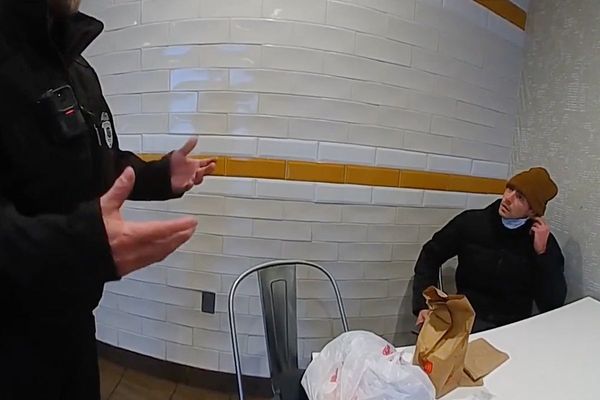
Mariupol, Ukraine – Setting out across flat waters in the space between where the grey sea and sky meet, Ukraine’s coastguard patrol the Sea of Azov looks for unregistered vessels, contraband and, since 2014, Russian warships.
The world’s shallowest sea sits precariously between Ukraine, Russia, and annexed Crimea. With winters in the region so cold the sea freezes over during the early months of the year, the thaw that arrived this week brought with it a new struggle – the threat of a coastal invasion.
“We used to watch fishing boats and nothing else,” says Ihor Chertov, deputy head of the coastguard unit in Ukraine’s eastern port city of Mariupol.
“Now, it’s the muscles of the aggressor state Russia who always try to push the boundaries and come closer to the shoreline than they’re legally allowed to.”
While all eyes are on 10 days of military drills in Ukraine’s northern neighbour Belarus and fears of an attempt to take the capital Kyiv, Russia has closed in by water, moving six warships and a submarine from the Mediterranean into the Black Sea.

A closure of the southern part of the Azov Sea for large-scale naval exercises next week was announced and then lifted, compounding confusion over Russia’s intentions as the West continues diplomatic efforts to ease tensions.
Raptor boats and attack helicopters have been seen on the move to Russian coastal positions, as Moscow’s ships patrol the water. The situation is especially claustrophobic in Mariupol – its port brings vital income into Ukraine through exports, while the city sits between the Russian border, territory controlled by pro-Moscow separatists and Crimea.
The peninsula was seized by Russian soldiers in 2014 and has remained under their control ever since.
“Russian ships are 50 to 60 metres (164-197 feet) long and you should understand, they haven’t just showed up – they’re always stationed here. Always watching, since 2014,” says Chertov, 47, looking out over a sea that is calm despite its surroundings.
He has served with the marine guards for 27 years, and knows all too well what is at stake if the current tensions spill into conflict – he previously served in Crimea, leaving just before the Russian forces arrived, and his parents still live there.

Life under the long arm of Russian President Vladamir Putin is subject to many restrictions, and Chertov is too concerned for their safety to criticise Moscow openly.
In December, he was the head of the ship when a Russian vessel entered the trade port, already in jeopardy because of Russian restrictions on the freedom of navigation. Both Russia and Ukraine have equal rights to use the Azov Sea, but Moscow claims control of the Kerch Strait – the only narrow way in.
“We had to approach the boat at a proximity that wasn’t comfortable for us physically and chase them away,” he says. “Anything can be expected from Russia.”
The Russian navy has been harassing Ukrainian ships for nearly a decade, and in 2018 three Ukrainian military vessels were hijacked by the Russian border guard and 24 sailors were taken hostage.
Mariupol’s coastguard said they are preparing themselves now by undertaking extra training, especially in how to deploy drones and deal with enemy ones.
Captain Oleksandr Surkov, 32, of the coastguard boat Onyx, is from Mariupol and has served in the coastguard since 2007. He says the Russian navy often tries to goad them into making the first move in an attempt to stir up trouble.
“They are always trying to provoke the Ukrainian side. They get into our waters and wait until our third warning to leave, always trying to push the boundaries by coming too close,” he says.

On Thursday, US President Joe Biden urged Americans in Ukraine to leave the country immediately, warning “things could go crazy quickly” in the region. UK Prime Minister Boris Johnson said the crisis has entered “the most dangerous moment” during a visit to NATO’s headquarters.
Both have been accused of exaggerating the current threat posed by Russia, while Ukraine’s President Volodymyr Zelenskyy is thought to be downplaying it.
However, with tensions so fraught, any misstep could tip a crisis into a full-blown conflict, and if a Russian ship approaches closer than 700 metres (2,297 feet), or 3km (1.86 miles) for the larger vessels, the Azov Sea coastguard is supposed to shoot.
For Surkov, who remembers the battles fought in Mariupol in 2014 after Russian-backed separatists briefly took control of the city, Russia should stop trying to elicit a reaction and leave Ukraine in peace.
“Just stick to your own territory, OK, there’s no need to come here,” he says.







